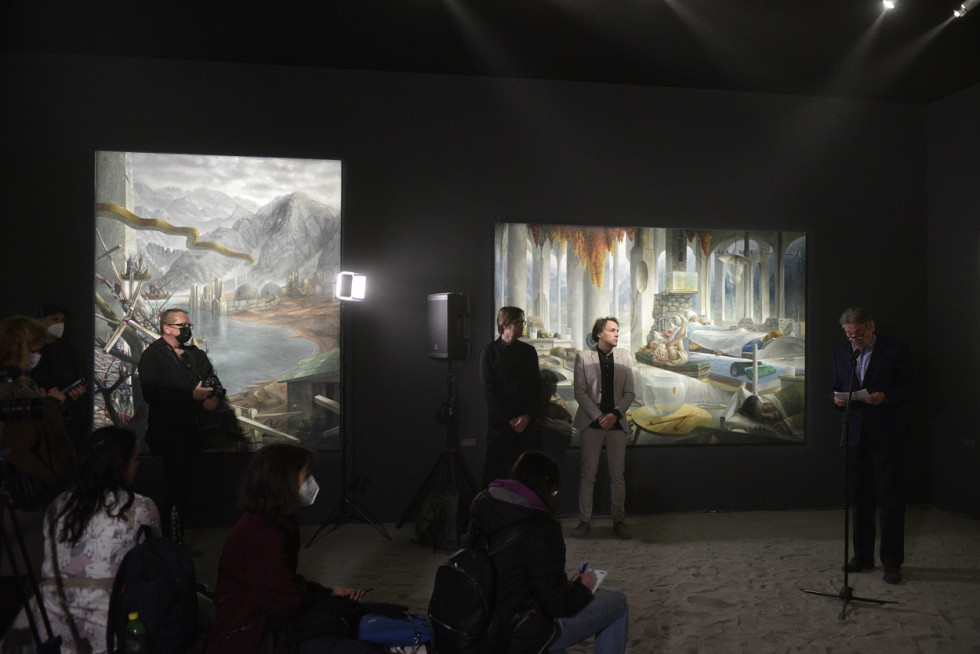Speech by the Minister of Culture of the Republic of Slovenia at the opening of Slovenian pavilion at 59th Venice Biennale

Slovenian pavilion at 59th Venice Biennale with the exhibition of paintings by Marko Jakše, one of Slovenia's most acclaimed painters | Author Dejan Habicht/Moderna galerija
Speech by the Minister of Culture of the Republic of Slovenia Vasko Simoniti
Dear guests, ladies and gentlemen.
I would like to extend a warm welcome to you all on the occasion of the opening of the Slovenian Pavilion here in Venice at this year's 59th Biennial of Fine Arts, where Slovenia is represented by the great painter Marko Jakše. As you know artists are inevitably unconventional, often misunderstood, eccentric, sometimes insulated into contemplative isolation, other times proactively involved in political movements and manifestations. Yet they always portray ourselves – in colorful ways and often more real than preserved memory stored in the historical timeline. That is why I am particularly pleased that, despite the relentlessness of everyday reality, this year's Biennial once again addresses the artist's imagination.
Visual artists, painters in particular, are at times reluctant to hear that their paintings are talked about at great length. Visual arts have their own language, their own intrinsic spontaneity, which opens the way to the imagination in a way a spoken language is unable to. Allow me to start with one of Jakše's paintings that made a profound impression on me: the painting entitled Reconvalescence from 2011. The painting shows seven human figures lying in a room that perhaps reminds us of a hospital. Most of them have their eyes closed, yet one lifts weights as if participating in physiotherapy. A child or infant raises its feet in the air. A third figure (if we look closely, we notice that it shares a bed with two others) is squinting its eyes. However as there these people are slowly returning to a healthy state of being, while they are slowly waking up, their environment also reminds us of a brief moments of our consciousness between dreams and lucidity. Everything is a little transposed, a tad vague. Orange spruces grow from the ceiling, but if we look closely, they may as well be stalactites. An aquarium appears on the wall. A tightrope, with pigeons swaying on it, stretches between the pillars.
In fact, dreaming is no more peculiar than being awake. While we sleep, scenes from our dreams seem entirely logical to us. It is only when they collide with awakening, only at that dull morning hour, that a sense of absurdity arises and forces us to merge two completely opposite worlds, and the strangeness stems precisely from this attempt to unite things that do not belong together. André Breton, author of the first Surrealist Manifesto (1924), wrote about this phenomenon. He postulates artists should henceforth combine "those two seemingly contradictory states, dreams and reality, into a kind of absolute reality, into surreality." A century later, the comparison with Jakše cannot be dismissed. I will not delve into possible guesses about sources or influences; this is the work for critics and art historians. Notwithstanding if the task of visual arts according to surrealism is to grant us a chance to combine those things that usually do not belong together, to allow the imagination to flourish outside the ordinary rules of the game, then surely, we can admire such unusual juxtapositions in Jakše's paintings.
An exhibition of Jakše's paintings is thus perhaps particularly appropriate given the theme of this year's Venice Bienniale – The Milk of Dreams; this title is taken from a book by surrealist painter Leonora Carrington. Carrington, who died only in 2011 at the age of 94, was one of the last survivors of the original Surrealist movement. Born in Britain and spent most of her life in Mexico, she was both a painter and a writer. Her works are sometimes described as surrealism with a special English twist: they are imbued with absurdity and comedic tales reminiscent of Lewis Carroll’s Alice in Wonderland. In her illustrated novel The Hearing Trumpet the 92-year-old woman travels the world ravaged by a nuclear bomb. This, however, is not a story of despair, but a hilarious adventure in which, through unusual characters, Carrington imagines an optimistic and perhaps even feminist future. If the time of this book, published in 1974, was permeated with fear of nuclear annihilation, even today it seems that future of mankind is full of peril and problems from which we see almost no way out, whether we are talking about a new war in Europe or climate change. Even today one possible view of the world is supposed to be imbued with humor and with the absurd. Perhaps with this understanding, the curator of this year's biennial, Cecilia Alemani, chose The Milk of Dreams as the main theme. As she writes, she wants the exhibition to explore some of the issues facing humanity today, through the prism of imagination. "What constitutes life, what differentiates plant and animal, human and non-human?" she ponders. "How is the definition of human changing? What are our responsibilities towards the planet, other people, and other life forms?"
The answers to some of these questions can perhaps be imagined through the works of Marko Jakše. Art, of course, delivers its answers in a peculiar way. It catches us in that brief moment between awakened state and sleeping, when everything seems possible, when we experience the world with completely different eyes.
Congratulations to the author Marko Jakše and congratulations to the organizers of the exhibition and our participation in this distinguished world magazine of fine arts. As you visit the Slovenian exhibition and the rest of the Venice Biennale, my wish for you all is that the exhibited works of art provide you with new ways of looking at the world.
Thank you very much.

